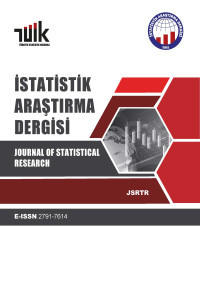Türkiye’deki Matematik Başarısının İki Aşamalı Bernoulli Modeli Kullanılarak İncelenmesi
İki aşamalı Bernoulli modeli, Matematik başarısı, PISA
Examining of Mathematics Achievement in Turkey Using Two Level Bernoulli Model
Two level Bernoulli model, Mathematics achievement, PISA,
___
- Aksit, N., 2007. Educational reform in Turkey. International Journal of Educational Development, 27, 129-137.
- Chiu, M., Xihua, Z., 2008. Family and motivation effects on mathematics achievement: Analyses of students in 41 countries. Learning and Instruction, 18, 321-336.
- Chow, B. W., Chiu M. M., Mebride-Chang, C., 2007. Universals and specifics in learning strategies: Explaining adolescent mathematics, science and reading achievement across 34 countries. Learning and Individual Differences, 17, 344-365.
- Dunn, C., Chambers, D., Rabren, K., 2004. Variables affecting students' decisions to drop out of school. Remedial and Special Education, 25, 314.
- Dünya Bankası, 2005. Okul öncesi eğitimden orta öğretime etkili, adil ve verimli bir eğitim sisteminin sürdürülebilir yolları. Rapor No: 32450-TU.
- Halpern, D. F., 2000. Sex differences in cognitive abilities. Third Edition, London: Erlbaum.
- Hammouri, H. A. M., 2004. Attitudinal and motivational variables related to mathematics achievement in Jordan: findings from the Third International Mathematics and Science Study (TIMSS). Educational Research, 46(3), 241-257.
- Heck, R. H., Thomas, S. L., 2000. An introduction to multilevel modeling techniques. Lawrence Erlbaum Associates, London.
- Hedeker, D., Gibbons, R., 1994. A random-effects ordinal regression model for multilevel analysis. Biometrics, 50(4), 933-944.
- Hox, J., 1998. Multilevel modeling: When and Why?. In: Balderjahnn, I., Mathar, R., ve Schader, M. (Eds.) Classification. Data Analysis, And Data Highways, Springer, New York, 147-154.
- Organisation for Economic Co-operation and Development, 2005. PISA 2003 Technical Report. Paris: OECD.
- Osborne, J., W., 2000. Advantages of hierarchical linear modeling. Practical Assessment, Research and Evaluation, 7(1), Available at: http://PAREonline.net/getvn.asp?v =7&n=1 (accessed June 1, 2005).
- Ramirez, M. J., 2006. Understanding the low mathematics achievement of Chilean students: A cross_national analysis using TIMSS data. International Journal of Educational Research, 45, 102-116.
- Raudenbush, S. W., Bryk, A. S., 2002. Hierarchical linear models: Applications and data analysis methods. Second Edition, Thousand Oaks, Sage Publications.
- Raudenbush, S. W., Bryk, A. Cheong, Y. F., Congdon, R., Toit, M., 2004. HLM 6: Hierarchical linear and nonlinear modeling. Lincolnwood. IL: Scientific Software International (second printing with revisions).
- Wang, D. B., 2004. Family background factors and mathematics success: A comparison of Chinese and US students. International Journal of Educational Research, 41, 40-54.
- Wilkins, J. L. M., 2004. Mathematics and Science Self-Concept: An International Investigation. The Journal of Experimental Education, 72(4), 331-346.
- ISSN: 1303-6319
- Başlangıç: 2002
- Yayıncı: TÜİK
Malmquist Endeksi ile 25 Ülkenin Ortaöğretim Performansının Değerlendirilmesi
Türk Reel Sektörü için Karşılaştırmalı Etkinlik Ölçümü: Veri Zarflama Analizi Uygulaması
Biyokimyasal Reaksiyonlar için Stokastik Simülasyon Algoritmalarına Genel Bir Bakış
Tekrar Satılabilir Ürünler için Gazeteci Çocuk Probleminin Çelişen Amaçlar Altında İncelenmesi
Umay UZUNOĞLU KOÇER, Mutlu KARA
Değişim Katsayılarının Eşitliğine İlişkin Testlerin I.Tip Hata ve Güç Bakımından Karşılaştırılması
Türkiye’deki Matematik Başarısının İki Aşamalı Bernoulli Modeli Kullanılarak İncelenmesi
Türkiye’de Enflasyon Katılığının Araştırılması: Parametrik Olmayan Bir Yaklaşım
Saygın ŞAHİNÖZ, Bedriye SARAÇOĞLU
Kapsamlı Bir İçerikle Ön Dağılım Türleri
Kümeleme Çözümlemesinde Düzeltilmiş Tek Adım M-Tahmin Edicisinin Kullanılması
